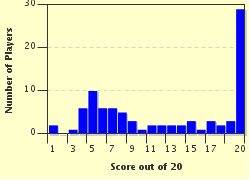Quiz Answer Key and Fun Facts
1. By modern critical convention, "All's Well That Ends Well" is listed among Shakespeare's so-called "problem plays". Which other three plays of the Bard's are traditionally lumped together with "All's Well" in this category?
2. Apart from "problem play", how else has "All's Well That Ends Well" most often been categorised by critics?
3. Shakespeare found his basic plot for "All's Well That Ends Well" in a book by William Paynter called "Palace of Pleasure" (1566), which also supplied the playwright with material for other works, including "Romeo and Juliet". Which Italian Renaissance humanist provided the original for Paynter's English translation?
4. In which European country or countries does the action of "All's Well That Ends Well" take place?
5. How are the characters dressed in the play's first scene?
6. What is Helena's first line in "All's Well That Ends Well"?
7. Which one of these statements is true of Helena in "All's Well That Ends Well"?
8. In line with the general neglect suffered by "All's Well That Ends Well" during the seventeenth century, which one of these statements is true of the song performed on stage by Lavatch the Clown for his mistress, the Countess?
9. What is the name of the young lord with whom Helena is in love?
10. What service does Helena perform for the King at the French court?
11. What action does Helena quickly take on hearing of her husband's flight from the French court?
12. Which one of these statements is *not* true of Bertram in the play?
13. What is the name of Bertram's flamboyant friend, whose name reflects his character and who utters one of the best-known lines in the play: "A young man married is a man that's marred"?
14. Which character in the play utters the catchphrase "all's well that ends well" twice as the plot moves towards its eventual resolution?
15. How many characters die during the action of "All's Well That Ends Well"?
16. Who speaks the play's Epilogue?
17. Whose name - the author of "Women Beware Women" and other interesting plays - has, in the twenty-first century, been put forward in scholarly circles as a possible collaborator with Shakespeare on "All's Well That Ends Well"?
18. What nickname was attached to "All's Well That Ends Well" during the eighteenth century?
19. Which eminent Irish playwright, intellectual and admirer of Henrik Ibsen once declared that "All's Well That Ends Well" was "a play rooted in my deepest affections"?
20. Which "grande dame" of the British theatre (who was born at Croydon, Surrey, in 1907) got rave reviews for her playing of the elderly Countess of Rossillion in the Royal Shakespeare Theatre production of "All's Well That Ends Well" at Stratford-upon-Avon in 1982?
Source: Author
londoneye98
This quiz was reviewed by FunTrivia editor
looney_tunes before going online.
Any errors found in FunTrivia content are routinely corrected through our feedback system.

